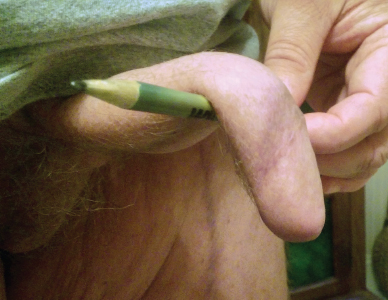CHAPTER 11 After phalloplasty and scrotoplasty, the neophallus is flaccid and the scrotum is empty.1,2 To make the newly constructed genitals look and function as natural as possible, scrotal and penile implants are needed.3 Most often these implant procedures are the last stage of reconstruction, preferably performed 1 year after phalloplasty. At that time most urethral complications will have been resolved, sensitivity will be present, and vascular integration of the phallus should be maximal, decreasing the risk of vascular complications during implantation. The testicular implants used after phalloplasty do not differ from those used in biologic males. Most often silicone gel–filled implants are used; they are available off the shelf in small, medium, and large sizes. The size used depends on the available space in the neophallus. If an inflatable erectile device is chosen, there must be extra space to accommodate the device’s pump. In most cases, the pump is large enough to fill half of the scrotum. As a consequence, most patients who choose an inflatable erectile device will need only one testicular prosthesis. With semirigid erectile devices, two testicular prostheses will be implanted, one along the incision used for the erectile implant and one by the contralateral inguinal incision. An inguinal incision in which to place the testicular prosthesis is recommended, because the scrotum often has many scars from the reconstruction. Reopening a scarred area increases the risk of wound infection and delayed or impaired wound healing in general. This in turn increases the risk of prosthesis infection and/or perforation. The space for the prosthesis is developed bluntly, starting at the inguinal incision. Testicular implants can dislocate from their original position, especially if too big a size is chosen for the area. Capsule formation and retraction are rare but can happen. Published reports on the clinical outcomes of testicular implant surgery in transmen are scarce. Some plastic surgeons tend to use tissue expanders in the labia majora to create space for the implants.4 In the technique of scrotoplasty described by Selvaggi et al,1 the surgeon performing the scrotal reconstruction tries to bring the scrotum in front of the legs (that is, the “natural” position). When the labia are preserved in their anatomic position and just closed in the midline, the patient will have problems with the testicular implants while sitting, and the chance of dislocation of the implants will increase. Rigidity of the neophallus is required to engage in sexual intercourse. However, obtaining rigidity after phalloplasty remains a real challenge, and many complications are reported.2,5,6 Different possibilities are available to obtain rigidity. When the phallus is constructed by use of a fibula flap or a radial forearm flap, theoretically part of the fibula or radius could be transplanted with the flap, thus allowing rigidity. Unfortunately, the limited amount of bone that can be taken from the distal radius or fibula can never function as a real rigidity device, and the risk of donor-site complications is substantially increased.7–9 In addition, bone or cartilage grafts may absorb or render a pointed deformity to the distal part of the penis, where the extra skin can glide around the end of the bone. Moreover, a phallus with a permanent erection can be an embarrassment that cannot be easily concealed.
Testicular and Erectile Implants in Transmen After Phalloplasty
Key Points
 Testicular and erectile implants complete the reconstruction in transmen after phalloplasty.
Testicular and erectile implants complete the reconstruction in transmen after phalloplasty.
 A delay of 12 months between phalloplasty and implants is recommended.
A delay of 12 months between phalloplasty and implants is recommended.
 The ideal phalloplasty implant is not yet available, and implants available to biologic men are still used today.
The ideal phalloplasty implant is not yet available, and implants available to biologic men are still used today.
 Erectile implants have a high complication rate because of the limited durability of the implant and the often high frequency of use.
Erectile implants have a high complication rate because of the limited durability of the implant and the often high frequency of use.
 Implants in transmen should be performed in high-volume centers.
Implants in transmen should be performed in high-volume centers.
Testicular Implants
Erectile Implants
Abdominal Key
Fastest Abdominal Insight Engine







